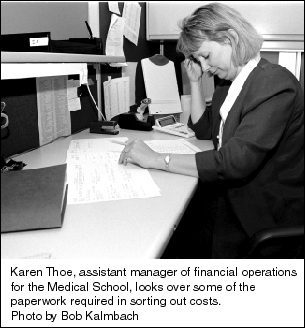The University Record, November 9, 1998
ABCM will help provide picture of costs
By Sally Pobojewski
Health System Public Relations
 How much does it cost to educate a medical student at the University of Michigan? William R. Elger, chief financial officer for the Medical School, says it’s an excellent question, and one that is not easy to answer.
How much does it cost to educate a medical student at the University of Michigan? William R. Elger, chief financial officer for the Medical School, says it’s an excellent question, and one that is not easy to answer.
“Right now, the honest answer is no one knows,” Elger says. “You hear cost estimates discussed occasionally, but none are based on a comprehensive analysis of all the activities involved in the educational process. Costs of education and patient care are so intertwined in academic medical centers, it is very difficult to separate them.”
Until recently, no one worried too much about differentiating educational costs from patient care expenses. In today’s health care environment, however, managed care companies and government officials want educational costs deducted when they negotiate contracts with health care providers.
Thanks to a technique called Activity Based Cost Management (ABCM) and hard work by a team of Medical School faculty and staff, Elger believes he soon may be able to answer this important question with something more accurate than an educated guess.
“ABCM allows managers to accurately determine the true costs of services by first identifying every activity required to deliver those services, and second determining the amount and cost of resources necessary for those activities,” Elger explains. “It has been used by private industry for years, but is just now moving into health care.”
According to Elger, ABCM is different from traditional cost accounting systems which take a fixed budget amount and spread it across units based on the volume of products or services each unit delivers. ABCM breaks down or “unbundles” costs associated with all the different activities required to provide a service or produce a product. Essentially, it’s the difference between a top-down and a bottom-up approach to costs.
To test the ABCM concept, the Medical School funded a six-month pilot project to evaluate the relative costs of purchasing supplies with a departmental credit card, a purchase order or a prime vendor with whom the University has a contractual relationship. The project involved staff from Purchasing Services, Financial Operations and several departments in the Medical School. Elger co-chaired the steering committee with Ken Donovan, business manager in Purchasing Services. The Medical School funded the project, purchased ABCM software and paid consultants to teach committee members how to use it.
“Using the software, we were able to document the true costs of each purchasing transaction,” Elger said. “The results showed that purchasing through a prime vendor is most cost-effective, but not suited to most small purchases. Total costs per transaction with purchase orders were nearly twice as high as total costs for credit card purchases. Individual department costs were about $2 higher per transaction with credit cards, however, than with purchase orders.” The study will be updated in January to include M-Pathways data.
Elger admits that the initial modeling of an activity with ABCM can be time-consuming, and it only works if people trust one another enough to share cost data across departments and administrative units. But he says the advantages are well worth it.
“It gives managers the information they need to manage costs more effectively and spot areas where changes in processing or procedures could reduce overall costs, not just shift costs to another unit. In an era of limited resources, we must continue to find new ways to provide services as efficiently as possible and to defend our costs to outside constituencies.”
“Bill Elger has shown outstanding leadership in bringing ABCM to the U-M,” said Tim Slottow, associate vice president for finance. “We see many opportunities for ABCM to help us gain a more robust understanding of the cost of services we provide to the University, and we hope to integrate it into day-to-day behavior within the University’s business operations.”
You can always drop us a line: [email protected].

